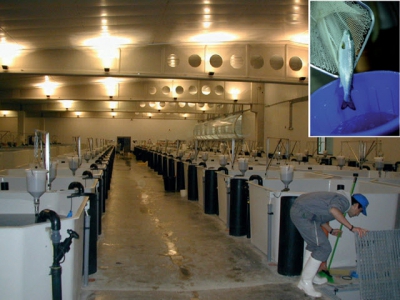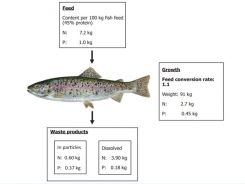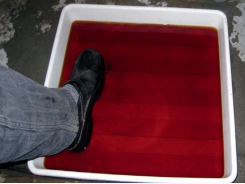A Guide to Recirculation Aquaculture - Part 12

Chapter 8: Case story examples
Figure 8.1 A recirculation smolt farm in Chile. Source: Bent.
Salmon smolt production in Chile
Growth in the Chilean salmon production during the 90s required an increasing supply of smolts from freshwater to be stocked in cages for grow-out at sea. Smolts were produced in river water or in lakes, where the water was too cold and the environment was suffering. Introducing recirculation helped smolt farmers to produce vast amounts at a significantly lower cost in an environmentally friendly manner. Also, the optimal rearing conditions resulted in faster growth, which made it possible to produce four smolt batches per year instead the previous one batch a year technology. This shift made the whole chain of production much smoother with a constant flow of smolt being stocked into the cages from where large salmon would be harvested at a constant rate at the right size ready for the market.
Turbot farming in China
Saltwater recirculation is a growing business producing many species such as grouper, barramundi, kingfish, halibut, flounder, etc. Turbot is a well suited species for recirculation technology which has been adopted also by Chinese producers. Production results from such installations have shown that turbot perform very well in a completely controlled environment. The optimal temperature for rearing turbot differs with size, and turbot are generally sensitive to changes in living conditions. The elimination of such changes apparently pays back in turbot farming as turbot of 2 kilos can be produced in two years compared to 4 years under normal rearing conditions.

Figure 8.2 A turbot farm in China. Source: AKVA group.
Model trout farms in Denmark
Denmark is without doubt the forerunner in environmentally safe trout farming. Strict environmental regulations have forced the trout farmers to introduce new technology in order to minimize the discharge from their farms. Recirculation was introduced by developing so-called model fish farms to increase production while at the same time lowering the environmental impact. Instead of using huge amount of water from the river, a limited amount of ground water from the upper layers is pumped into the farm and recirculated. The effect is significant, a more constant water temperature all year round together with a modern facility results in higher growth rates and a more efficient production with reduced costs, investment costs included. The positive effect of the environmental impact can be seen in Chapter 6.

Figure 8.3 A Danish model farm. Source: Kaare Michelsen, Danish Aquaculture.
Recirculation and re-stocking
Clean rivers and lakes and natural wild stocks have become an important environmental goal in many countries. Conserving nature by restoring natural habitats and re-stocking of endangered fish species or strains is one among many initiatives.
Sea trout is a popular sport fish that occupies many rivers in Denmark, where almost every river has its own strain. Genetic mapping carried out by scientists has made it possible to distinguish between different strains. When the sea trout becomes mature, it migrates back from the sea to its home river to spawn. In the part of Denmark called Funen, rivers have been restored and the remaining wild strains have been saved by a re-stocking programme involving recirculation aquaculture. Mature fish are caught by electrical fishing and eggs are stripped and reared in a recirculation facility. Approximately one year later, the offspring are re-stocked into the same river from where their parents were caught.
Different strains have been saved and in due time the sea trout will hopefully be able to survive by itself in this habitat.
Most importantly, this programme has also resulted in a significant better chance of catching sea trout when sport fishermen are fishing from the shores of Denmark. Fishing tourism has therefore become a good earning for local businesses such as hotels, camping sites, restaurants, etc. All in all, a win-win situation for both nature and local commercial interests.
Aquaponics
Growing plants and fish together has been accomplished already thousand years ago in ancient China. The plants grow by using the nutrients excreted from the fish, and both fish and plants can be harvested for consumption. In modern aquaculture the combination of growing fish in a recirculation system and growing greenhouse plants in hydroponics using nutrient water without soil is named “aquaponics”. The technology has yet to become industrialized, but is widely used in small scale around the globe.

Figure 8.4 Photo of aquaponics research at Institute of Global Food & Farming near Copenhagen, Denmark. The system is built in an existing greenhouse facility, and includes fish rearing tanks and salad tables together with a recirculating water system with two independent water loops. One of the loops run through a water filtering system and can be routed to plant tables or back to fish tanks. The other loop supplies water directly to plant tables for growing lettuce or herbs such as sage, basil and thyme. Source: Paul Rye Kledal, Institute for Global Food & Farming.
Mega farms
The size of fish farms is constantly growing as world production in aquaculture rises. Today, an average sea cage farm in the sea of Norway is producing around 5 000 tonnes of salmon per year, just at one site. Land based systems of this size have yet to be seen, but new recirculation projects for salmon and trout of these volumes are emerging.
Combining land based farms with cage farming is a very efficient way of production and probably the most competitive set-up. Small fish are produced on land in efficient and controlled systems before they are released into large sea cages for grow-out. In some areas cage farming is not popular, and land based farms in the form of recirculation plants are seen upon as a future way of producing farmed fish. The footprint is low and so is the water consumption. Although production costs are still higher than in cages, the systems have high food safety and complete control, and the output is constant and foreseeable.

Figure 8.5 A 2 000 tonnes salmon farm in Hirtshals, Denmark under the construction phase in 2013. The system is based on recirculation technology and is covered by a building for completion to control temperature and have high biosecurity. Salmon are grown from eggs to 4 kg size in 2 years in large tanks reaching almost 1 000 m3 each. The white bigbags in the foreground are packed with biomedia ready for installation in the biofilter chambers. Source: Axel/AKVA group.
Future of recirculation
Pre-ongrowing of fish in recirculation systems to reach larger sizes before releasing them into the sea cages is a way of increasing profitability. The Norwegian salmon farming industry is investing in large recirculation facilities with the aim of producing smolt to larger sizes. Smolts are typically 100 gram today when released in cages. An increase to 300 gram before stocking will improve health and growth rates significantly in the farming period until harvest at market size of typically 4-5 kg.

Figure 8.6 Recirculation systems become increasingly larger with bigger tanks to accommodate for increasing production volumes. Shifting smolt sizes in Norway from 100 gram to 300 gram will triple the land based production, thus current Norwegian smolt production on land of around 35 000 tonnes per year will increase to around 100 000 tonnes.
Có thể bạn quan tâm
Phần mềm

Phối trộn thức ăn chăn nuôi

Pha dung dịch thủy canh

Định mức cho tôm ăn

Phối trộn phân bón NPK

Xác định tỷ lệ tôm sống

Chuyển đổi đơn vị phân bón

Xác định công suất sục khí

Chuyển đổi đơn vị tôm

Tính diện tích nhà kính

Tính thể tích ao hồ



 Bright prospects ahead for shrimp exports to US…
Bright prospects ahead for shrimp exports to US…  Aquatic exports to China shows sign of recovery
Aquatic exports to China shows sign of recovery